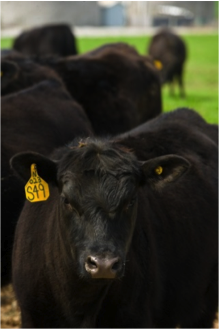Forage of the Month: Corn
 Corn is one of our most productive forages with the potential to produce more than seven tons of dry matter per acre. Few annual crops can compare to corn in terms of yield (dry matter per acre) and cost (per pound of gain). Grazing fully matured, standing corn during the winter months has proven to be a successful tool to extend the grazing season. It will help reduce feed costs as well as the investment in harvest. Winter grazing of corn typically occurs from mid-November to the end of December or later, depending on the amount of corn available. Consider the following management tips to help your operation get the most out of grazing corn.
Corn is one of our most productive forages with the potential to produce more than seven tons of dry matter per acre. Few annual crops can compare to corn in terms of yield (dry matter per acre) and cost (per pound of gain). Grazing fully matured, standing corn during the winter months has proven to be a successful tool to extend the grazing season. It will help reduce feed costs as well as the investment in harvest. Winter grazing of corn typically occurs from mid-November to the end of December or later, depending on the amount of corn available. Consider the following management tips to help your operation get the most out of grazing corn.
Corn is typically planted April 1 to May 15 in Kentucky. Corn has the nutritive composition to meet the requirements for many classes of livestock. However, as with any high quality feed, (corn) grain may increase the risk for digestive upsets or founder. To help reduce this risk, gradually adjust animals to corn. Limit grazing for the first few days to two to three hours. As plant quality decreases as seen with selective grazing, gradually let animals graze longer. Another way to reduce health risks is by offering alternative forages, such as hay or a nearby field of stockpiled tall fescue. Also check nitrate levels before grazing as corn may contain nitrates, specifically after a frost.
Protein and mineral supplementation should be based on the nutritional requirements of the animals grazing. When choosing a supplement, consider nutritional requirements, cost and availability of the supplement, and convenience and time required to feed. For proper bone development and maintenance, check that the calcium to phosphorus ratio is equivalent to 1.5:1 to 2:1.
Corn is utilized most efficiently by strip grazing. Strip grazing only allows livestock enough forage for a few days at a time by fencing off a portion of the field with temporary fencing. This reduces selective grazing and waste from trampling. Place the fence far enough away that a falling corn stalk could not fall on the fence and short it out. The size of the area allotted will be dependent on the nutritional requirements of animals grazing and quality of the corn. Keep in mind that cows will not want to lay down on corn stalks. Provide an area in the field free of corn stalks, or move them into an adjacent pasture so they can rest.
For agronomic considerations of corn, refer to A Comprehensive Guide to Corn Management in Kentucky.
Categories:
Summer
Species/Varieties


